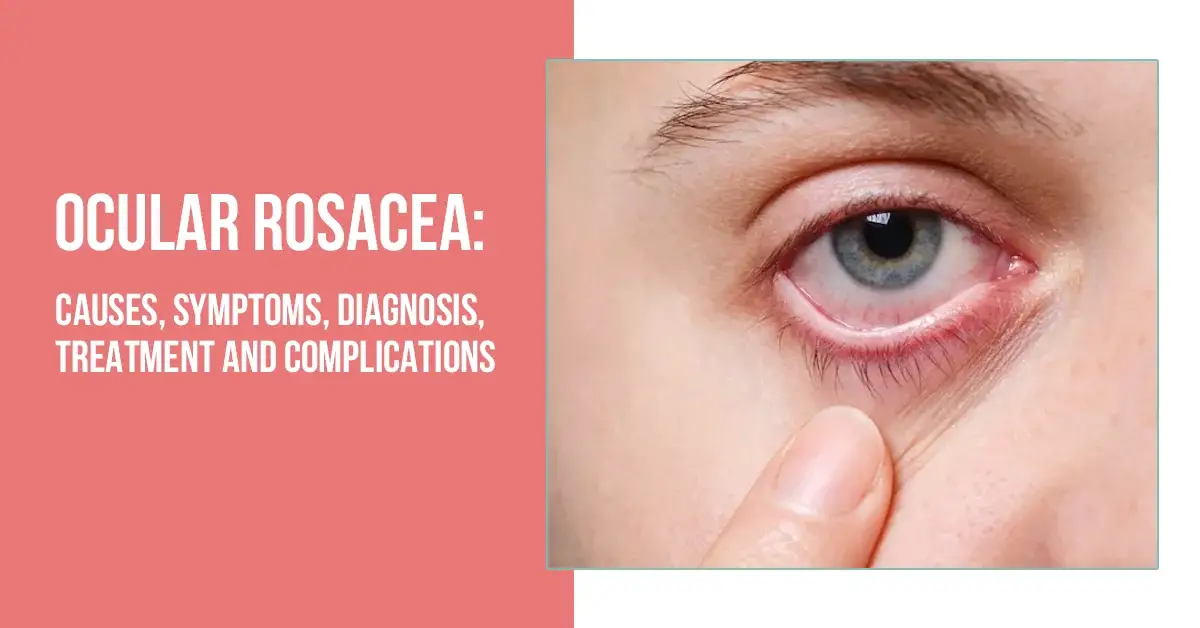
What is ocular rosacea? Symptoms and causes of ocular rosacea
Ocular rosacea: What you need to know
If your eyes are red, itchy, swollen, or you frequently develop styes, don’t ignore it. While these symptoms can be the result of environmental allergies or a simple blocked tear duct, they can also be a sign of a chronic condition called ocular rosacea.
What is ocular rosacea?
Ocular rosacea is a subtype of rosacea that causes inflammation and burning in the eyes and eyelids. Rosacea is a chronic skin disease that primarily affects women between the ages of 30 and 50.1. Up to 58% of people with rosacea have concomitant eye problems, with men and women affected equally. However, 20% of cases of ocular rosacea have no skin symptoms prior to diagnosis. 2,3 This means that you can have ocular rosacea even if you don’t have symptoms of rosacea.
Symptoms and causes of ocular rosacea
Symptoms of ocular rosacea can affect any part of the eye, including the eyelids. You may notice one or more of the following symptoms frequently.
Red, itchy, burning, or watery eyes
Grainy feeling or feeling as if something has entered your eye
Dry eyes
Sensitivity to light
Eyelid inflammation (blepharitis)
Visible thin veins in the eyelids near the eyelashes
Recurrent eyelid infections, such as styes or hailstones
Inflammation of the cornea, which may cause blurred vision or vision loss
The cause of ocular rosacea is unknown, but it may be related to one or more of the following:
Genetics: If one or both of your parents have rosacea, you are also at a higher risk of developing rosacea
Bacterial infection: Helicobacter pylori, which usually affects the intestines, can also cause eye inflammation.
Blocked eyelid glands: A condition called meibomian gland dysfunction means that your eyelid glands don’t produce enough oil to prevent your eyes from drying out.
Eyelash mites: While everyone has eyelash mites, people with rosacea tend to have more of them than normal, which can cause inflammation.
How is ocular rosacea diagnosed?
There is no specific test to diagnose ocular rosacea. Instead, your doctor will determine the cause of your symptoms based on your medical history and observations from an eye exam.
Ocular rosacea is diagnosed when you have at least two symptoms, including rosacea skin symptoms.
Ocular rosacea is classified into three grades:
Grade 1: Mild itching, burning, sandy sensation in eyes
Grade 2: Burning, stinging, or crusting in eyes and eyelids
Grade 3: Pain, sensitivity to light, or blurred vision
How to Treat Ocular Rosacea
Treatment of ocular rosacea depends on the severity of the condition. Treatment can relieve symptoms, but there is no cure for this chronic condition. It is important to treat your symptoms because, if left untreated, ocular rosacea may lead to permanent vision loss. It is always recommended to see a specialist to get a proper diagnosis and treatment plan.
Initial treatment includes good eyelid hygiene.
Wash your eyelids twice a day with warm water or baby shampoo.
Use artificial tears to relieve dry eyes if necessary.
Avoid makeup if your eyes are sore. If you wear makeup, choose non-greasy or fragrance-free products.
Do not wear contact lenses if your eyes are irritated, especially if they are dry.
Avoid certain rosacea triggers, such as spicy foods or alcohol.
For more severe symptoms, your doctor may prescribe oral antibiotics, such as doxycycline, tetracycline, minocycline, azithromycin, or erythromycin, to treat infection and inflammation. They are usually given at lower doses for longer periods of time to treat inflammation.
Topical steroid medications may be prescribed when other antibiotics have failed to resolve inflammation, corneal damage, or chronic eye irritation. They are only used short-term, as long-term use of steroids may cause other eye problems, such as glaucoma or cataracts.
An alternative to treating inflammation with steroids is topical cyclosporine, an immunosuppressant that is particularly helpful for dry eyes. It is safer to use long-term than steroids.
Some studies have shown that omega-3 fatty acids can relieve dry eye symptoms.
Hail or styes that don’t respond to other treatments can be removed surgically.
Avoiding rosacea flare-ups with ocular rosacea
Ocular rosacea has the same triggers as rosacea. If you have both ocular rosacea and rosacea, the same conditions can cause red spots on your skin and eyes. Common triggers are:
Spicy foods
Alcohol
Sunlight, wind or extreme temperatures
Extreme emotions, especially stress, anger or embarrassment
Intense physical activity
Taking a hot bath or sauna
When to see a doctor
If you have burning, red or itchy eyes, see your GP. If he suspects you have ocular rosacea, he will refer you to your optician or ophthalmologist.
You should also see an ophthalmologist if your ocular rosacea symptoms get worse or flare-ups become more frequent. Tell them if you have any new symptoms or triggers.
Go to the emergency department if you experience pain, dizziness, vision loss, blurred vision or double vision.
Living with Ocular Rosacea
While there is no cure for ocular rosacea, regular treatment and good eye hygiene can control symptoms and prevent disease progression. Work with your doctor to determine a disease management routine that’s right for you.


